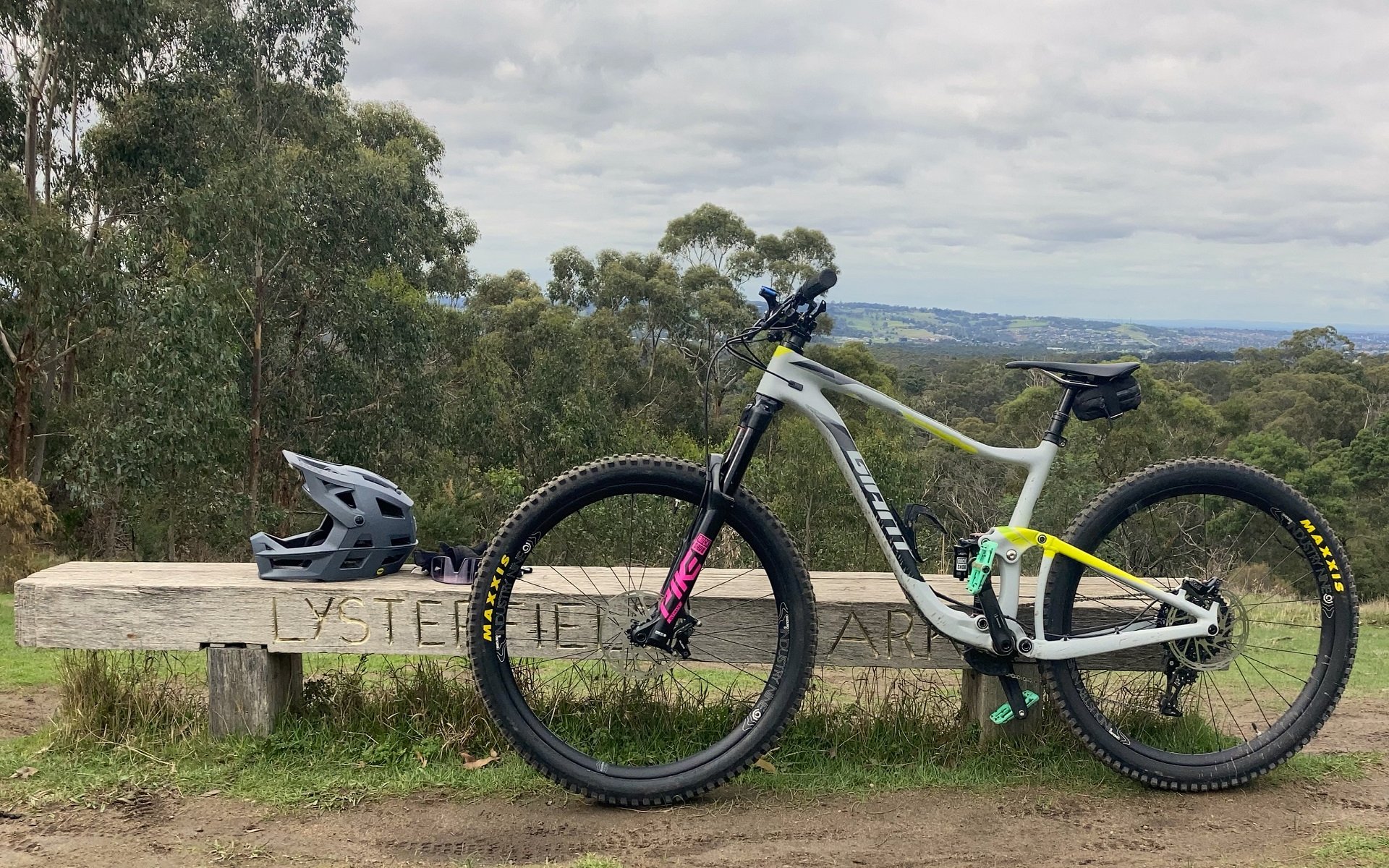
MIN MAX
Min-Max: Andrew's 2017 Giant Anthem Advanced SX
SX²
Andrew Stone took his five-year-old Anthem SX, tossed in a -2° angleset, bumped the fork travel up to 140mm, and stuck in a 180mm dropper post. The end result? A level of capability and componentry that actually resembles the "confidence and control on rugged trails" marketing that Giant dropped when they stuck an extra 1cm of fork travel, some Nobby Nics, and the 'SX' tag onto their 27" XC Race Anthem.
Wheel size aside, some of the most exciting meat-powered rigs on the market right now aren't a huge leap from the thinking behind Andrew's version the SX. I'm thinking of the new Element, Spur, HeiHei, the Blur that Pete reviewed, Epic Evo, and certainly the Top Fuel that Cooper just finished with. Nuances aside, rubber choice dependent, these bikes are go climb nicely under your own steam, absolutely rip on undulating trails - even really technical ones, and go down most trails with a bit less speed and minimal loss of fun factor compared to much longer travel rigs. Whatever micro-category you'd prefer to assign to them, these bikes are probably the most worthy of the original all-encompassing mantle of 'mountain bike.
There are different takes on what the perfect shorter-travel package is between around 120mm and around 140mm. For the slightly longer travel camp, I love the saying I've heard at least a few times that a "Stumpjumper never stopped being a Stumpjumper." Which is to say you can follow that bike from it's fully rigid inception, through to the interrupted seat tube models, and on to today's flex-stay rig with 130mm rear travel and 140mm fork travel and capture what most folks 'need' to ride most trails the world over. Interesting brain food maybe, even if you're own 'mountain bike' is a very different machine.
...and most importantly new pike stickers in OG RS1 pink" - Andrew Stone
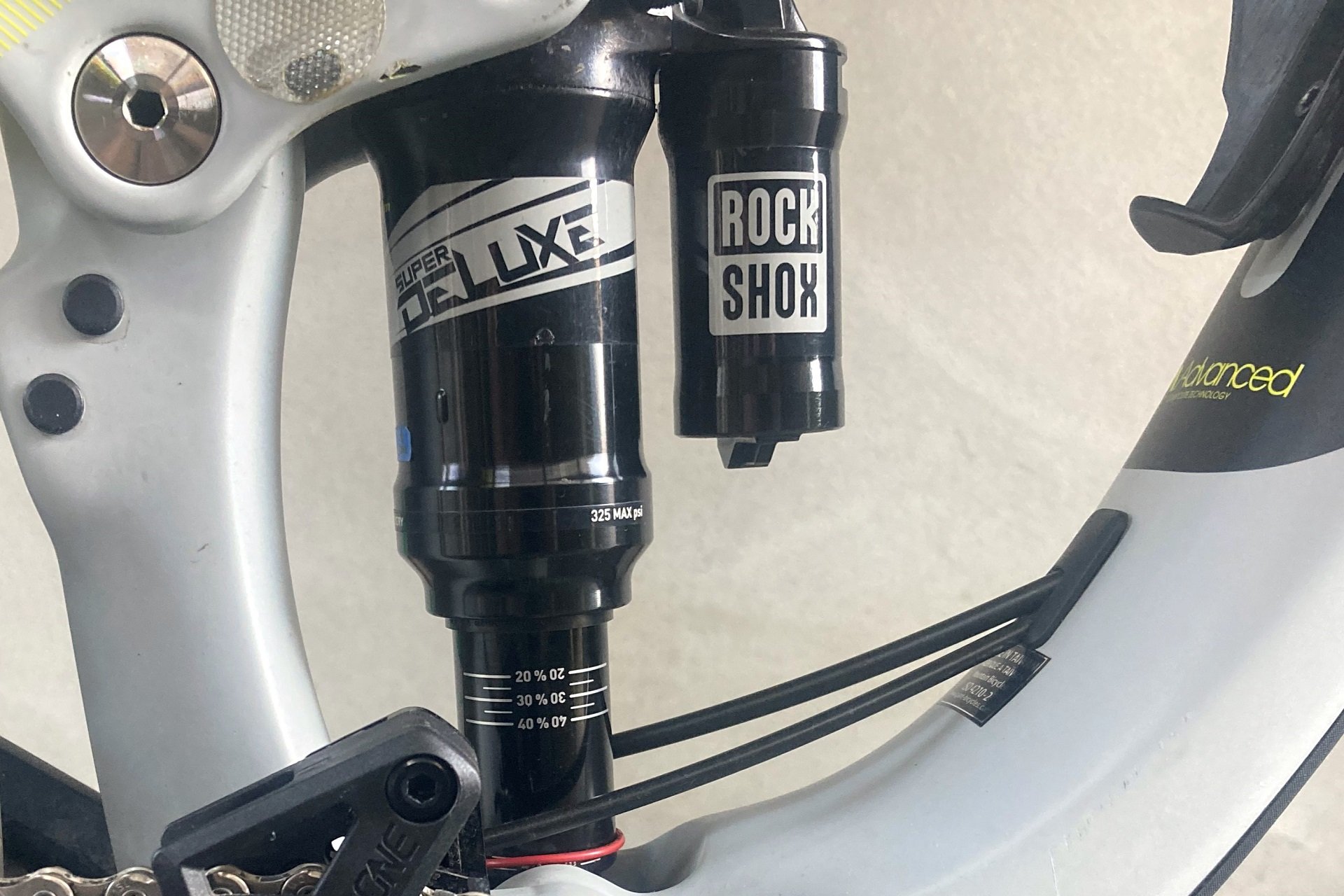
The piggyback shock is stock. On a 110mm bike I think this was more for the aesthetic then the extra oil volume. Certainly a replacement shock would be an inline model.
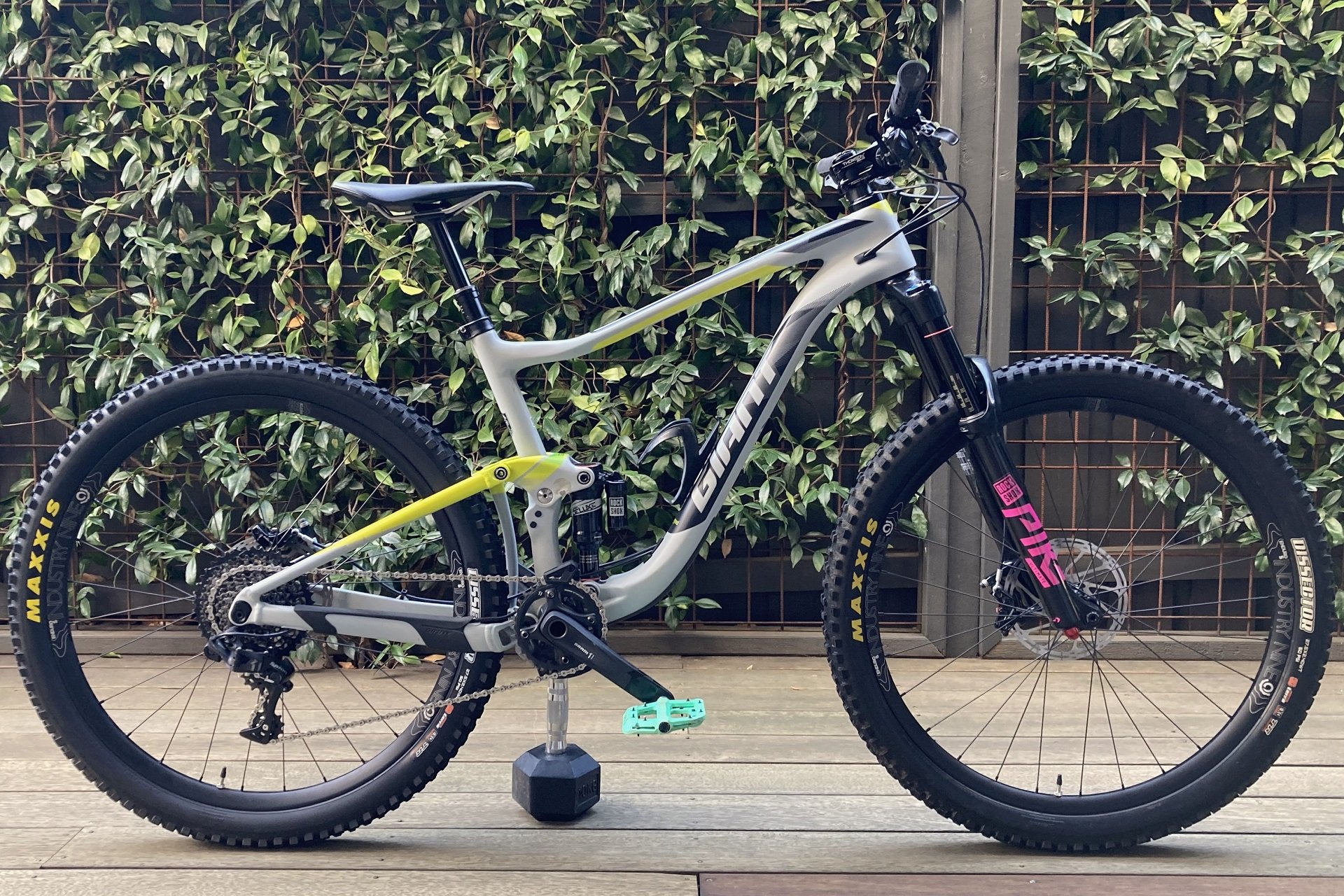
Shock service, linkage service, fork service with a new air shaft to make it 140mm travel instead of 130mm. Maestro suspension works very well in shorter travel applications.
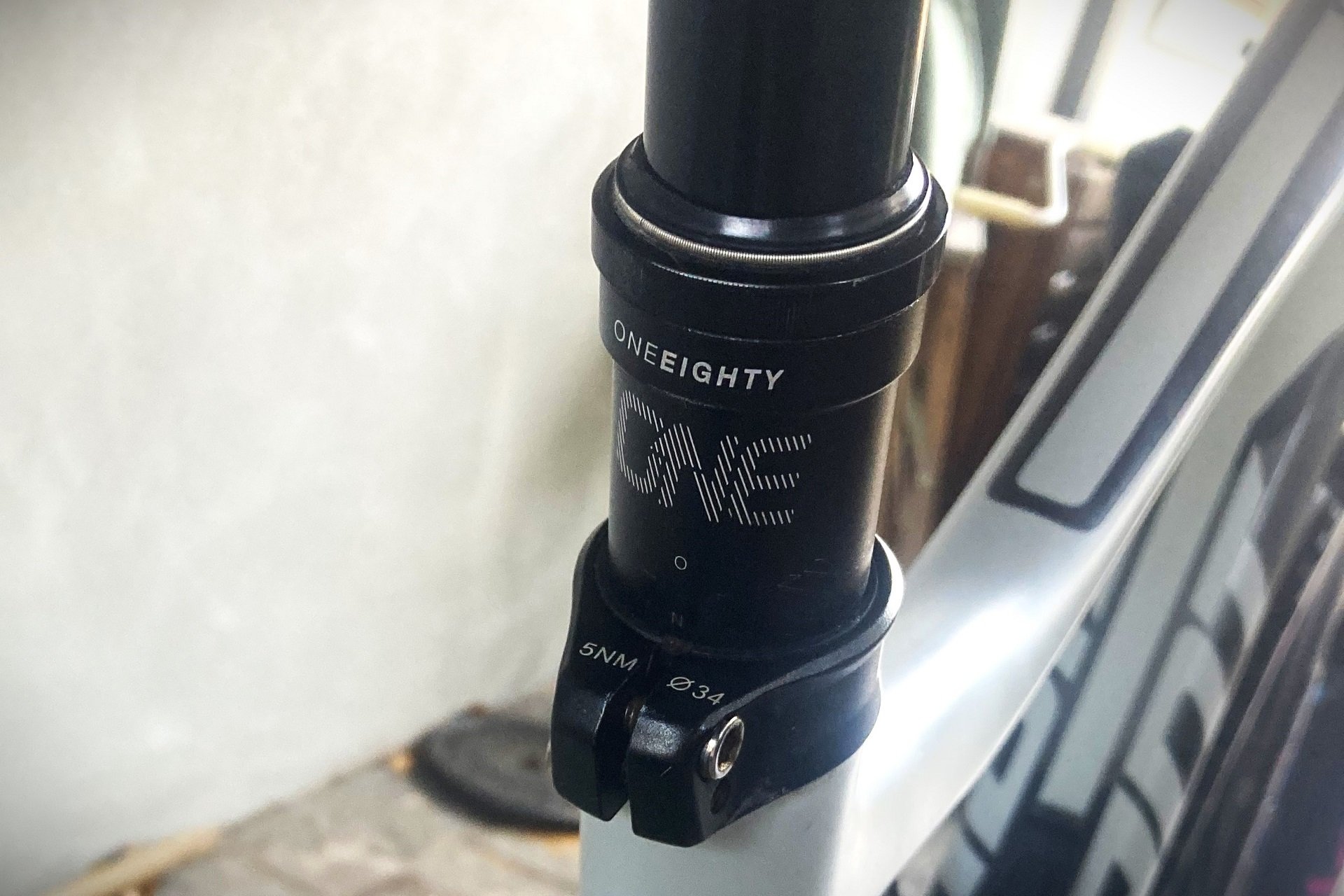
Andrew has clearly proclaimed his intentions for this rig with the addition of a 180mm travel OneUp V2 dropper post. Bike body separation!
Even in 2017 terms, the stock Anthem Advanced SX was a fairly boring rig. It shared the same 110mm travel aluminum rear end and carbon front end with the straight-up Anthem; in Giant's words a "state-of-the-art XC bike." The whole package was spiced up with an extra 1cm of fork travel, the piggyback shock aesthetic, and very slightly more aggressive rubber. The brakes on the top end SRAM-equipped models were also upgraded from the two-piston Level model (for level ground) to the four-piston Guide. And yes, maybe I'm overly critical, but I don't really see how that warranted adding a new model and a bunch of sizing SKUs.
Built the way Andrew has it set up, with an angleset, this bike is a lot more interesting. I'd say it's a brake upgrade away from being buttoned up as a super fun rocket ship. In my experience, these short travel bikes are amazing at getting the rider into trouble but with 4-5" of suspension it takes quick wits and big brakes to get out. If Andrew's Guide brakes are in good shape one easy hack is to purchase a set of Code calipers and bleed everything up. Otherwise there are lots of good choices from best-on-a-budget Code-R or Magura Trail Sport to any number of pricier choices.
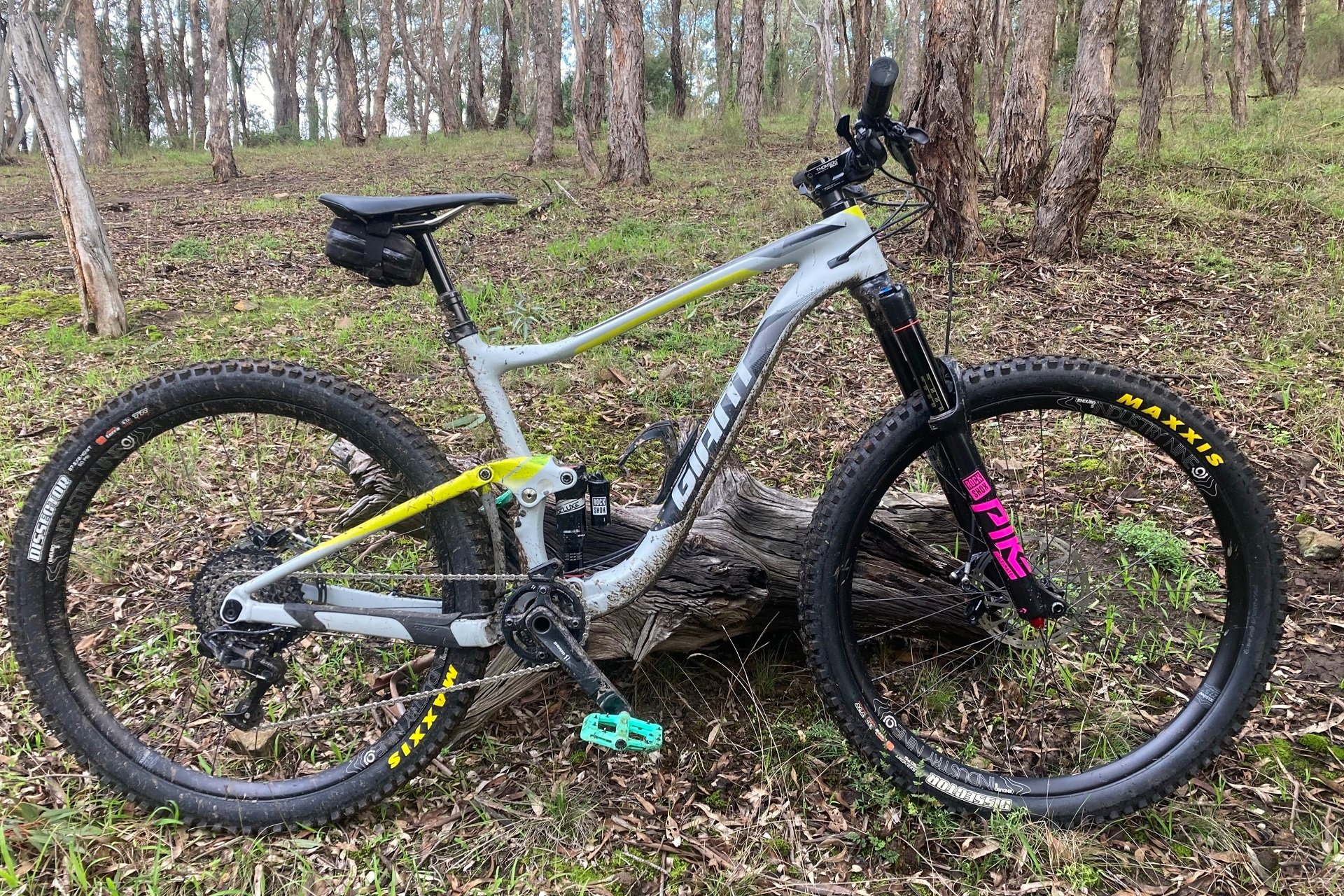
I'm not about to ask Andrew if the combination of the saddle bag, 180mm of drop, and 110mm of suspension travel all clear at bottom out. I mean, I'm certainly he'd notice if they didn't. I'd still be tempted to move the storage inside the front triangle.
Longer, (S)lower, Slacker
Tires are perhaps the quickest, way to change the character of a bike. Never mind the tread pattern, a more supple casing with a firmer durometer of knobs rolls much faster. It's an easy, if not cheap test to conduct on any bike. Grab a pair of Maxxis EXO MaxxTerra tires and the same sized rubber in a DoubleDown casing with MaxxGrip and go ride them. Even the difference between two MaxxGrip tires, EXO v. DoubleDown, the difference is noticeable by most riders.
One way to resolve the need for durability and support with a desire for faster rolling is to run the lighter casing tire with an insert. Essentially dividing the two tasks between two products. This is how I've ended up riding grippy tires with lighter casings, and big inserts, on my personal bikes. Another way is simply to suck it up and go pedal up whatever tires you're most comfortable riding downhill.
Tires are also very location specific as Andrew's Giant shows. Where the Maxxis Dissector in any casing or compound is a 'sometimes' tire on the North Shore that can be terrifying on roots and rocks at certain times of the year, it's a front and rear favourite in other locales. His Giant is running the lightest EXO sidewall version, and the firmer MaxxTerra 3C compound, in a 2.4" size. These will roll uphill a bit slower than the paired Nobby Nic tires that came with the bike, a 2.25" rear and a 2.35" front, while still rolling quickly across terrain and downhill while bringing significantly more cornering grip.
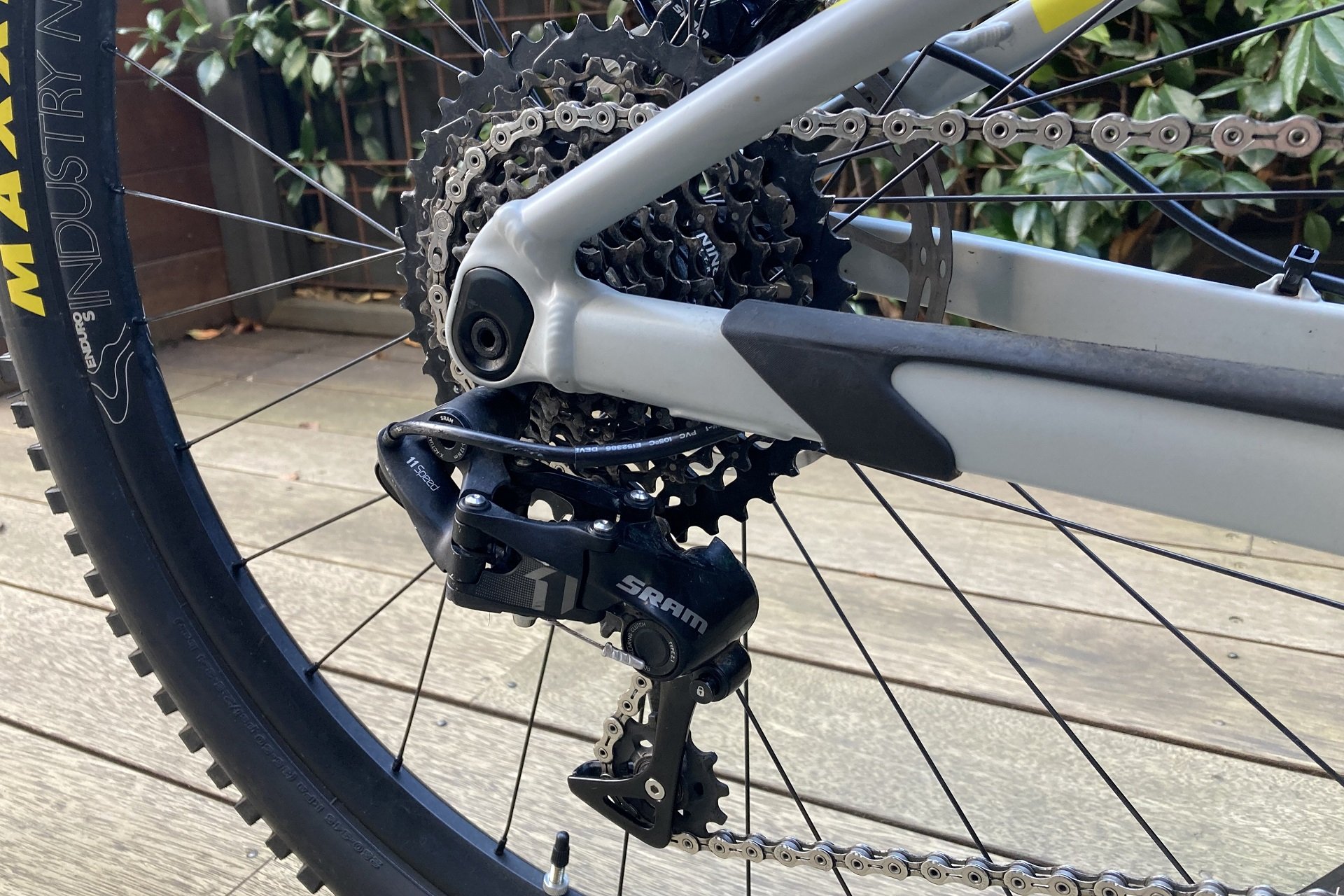
The 11-speed SRAM X1 rear derailleur is still shifting strong. Funny to think that it wasn't that long ago a 42t low gear looked pretty massive.
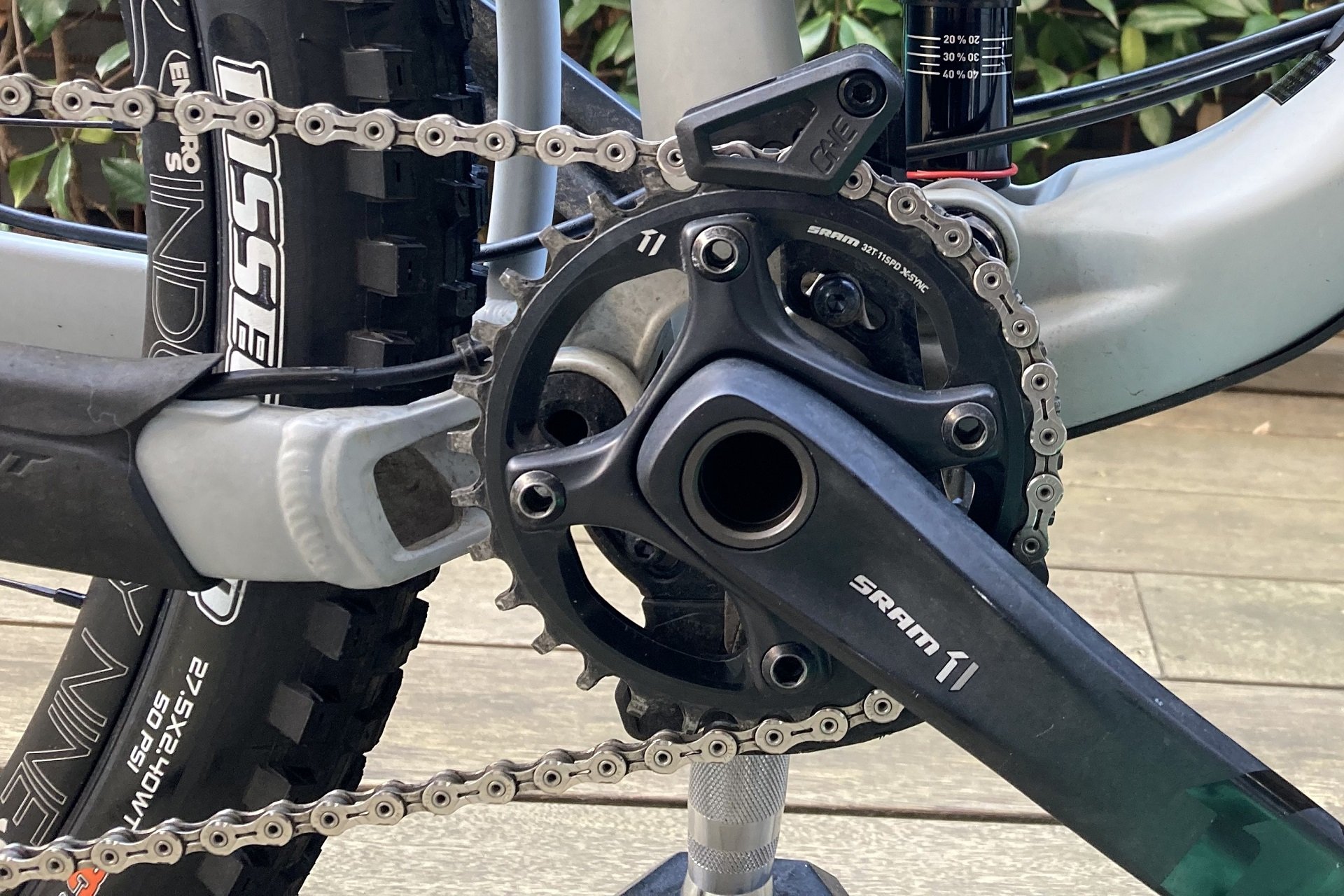
Do you use a top guide? I figure if Redbull Rampage contestants can do without so can I. I mean, as long as the narrow-wide ring is fairly fresh.
These shorter-travel but still DH-fun full suspension bikes continue to be defined by their shoes and as tires go the lightweight 2.4" category is probably the most interesting to follow in terms of development and technology. It also makes it difficult to talk about two bikes comparatively without running the same tires on each. For example, I had very different experiences with the Canyon Lux Trail between running a DHR2 on the front and a Recon. The added fun-factor was worth every second on the climb to me, but a true connoisseur of the category may have found love with something in between, like the new Forekaster or Bontrager's XR4, maybe Schwalbe's Wicked Will, or maybe a Continental Trail King?
The list and variety of opinions, both terrain specific and generally, are endless. The point I'm drilling down to is that I was very surprised to see dual-Dissectors but tires are expensive and terrain varies, so when you're spec'ing your aggressive short travel sled local knowledge from folks who ride that sort of rig is going to trump all.
A more universal upgrade is going to be wheels. The stock Giant XCT-1 wheelset has modern stats with an i29 rim width, 28x spokes, and a Boost front and rear axle widths but the key in this category of bike is to choose rims, carbon or aluminum, that are going to min-max weight with toughness. Tire pressure is going to be a key part of bicycle setup with the firmer-rubber, faster rolling setups and dent resistance is key. Andrew is running an Industry Nine Enduro S wheelset which combines their top end Hydra hub with an i30.5 rim that I9 says is suitable for a 2.3-2.8" tire, and I'd argue will work best in a 2.3"-2.6" window, which could open up some interesting higher volume rubber choices.
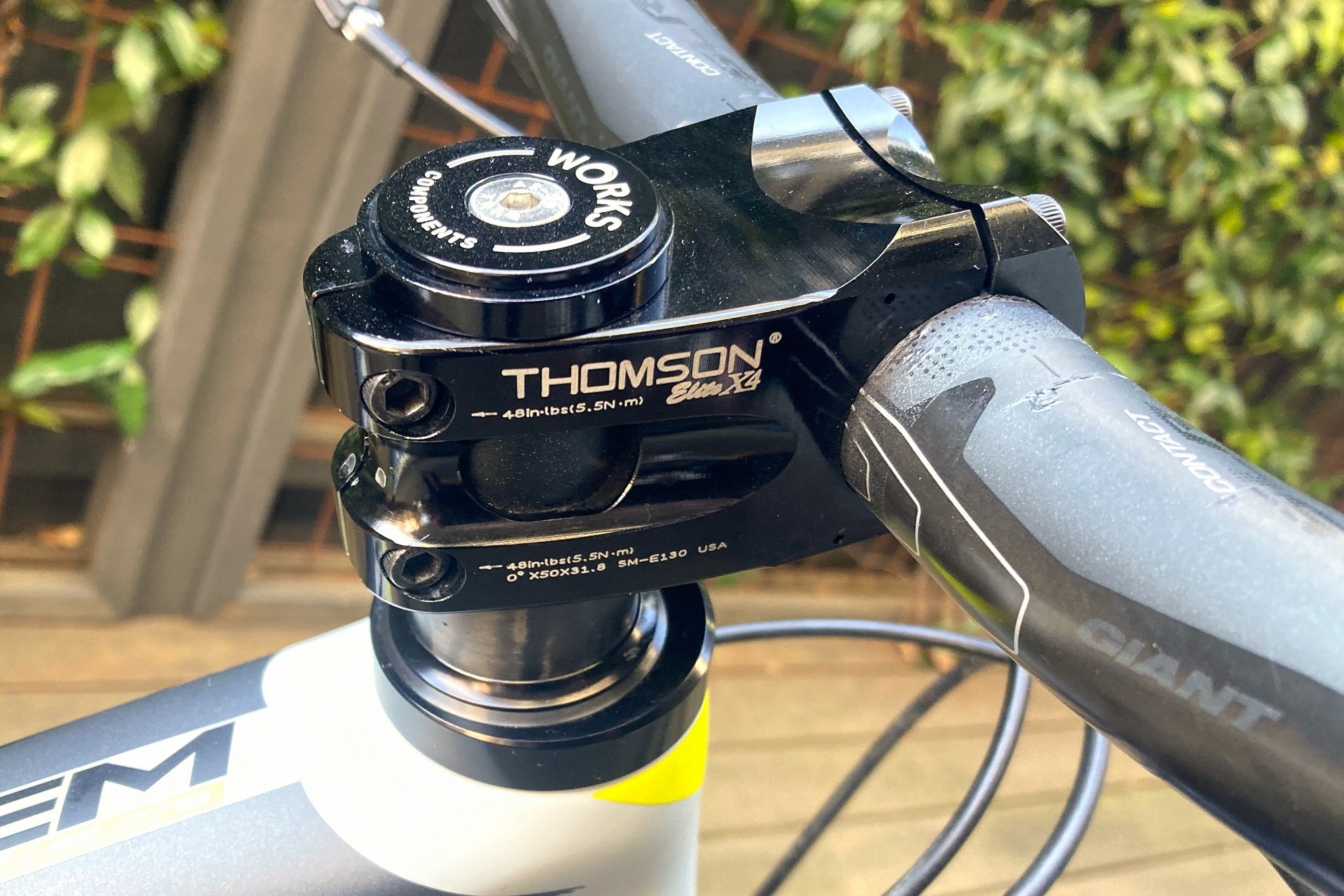
I don't see much talk about Thomson stems anymore‽ They used to be ubiquitous on high-end builds. This one has the classic 4mm Hex-head bolts instead of the later 3mm. Good stuff, as is the Works Components -2° Angleset as well.
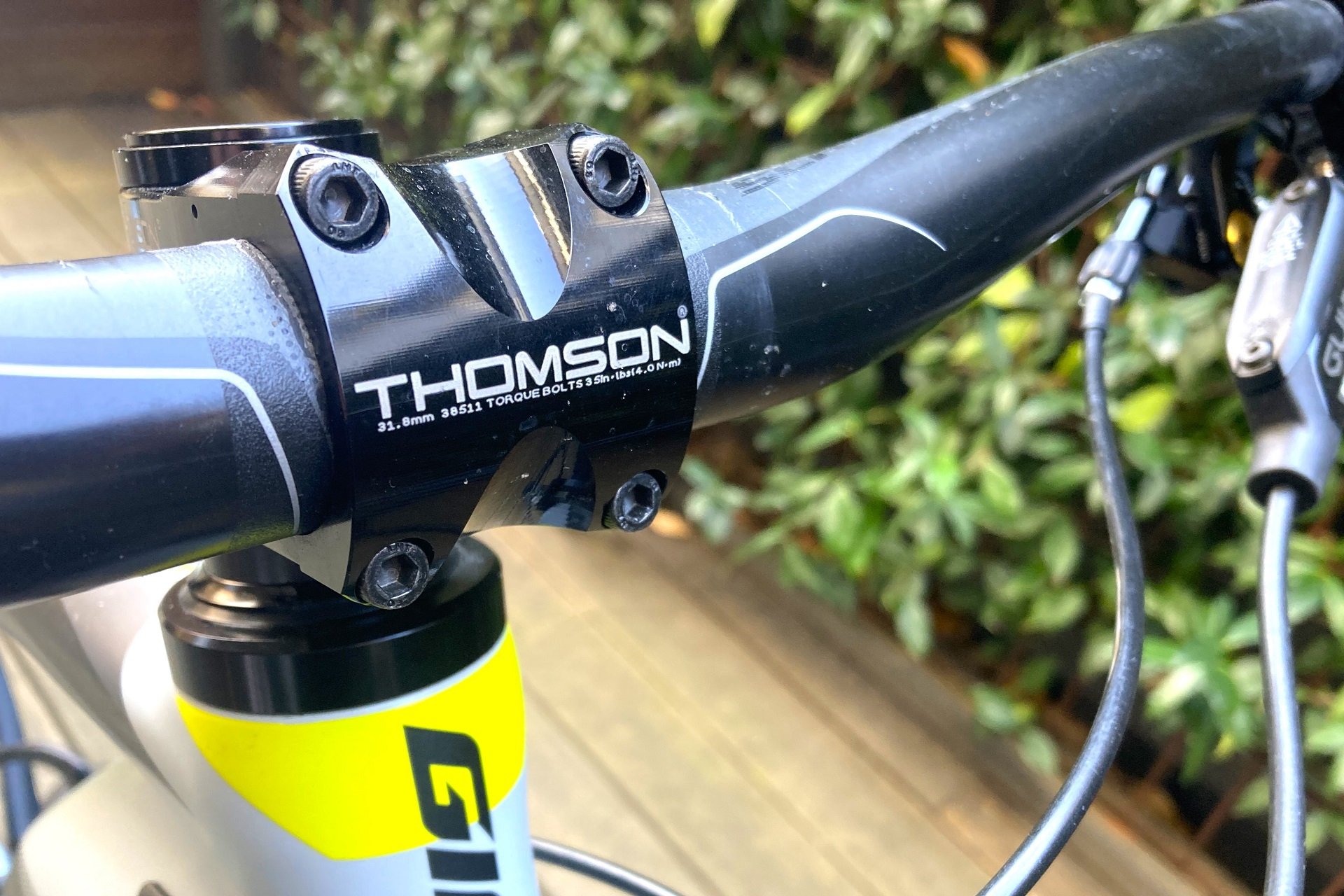
I'd retire the five year old carbon handlebar, regardless of the condition. I also would replace the bar on any used bike I was buying right away. But, that's a personal decision and I'm not telling Andrew, or you, what to do.
Andrew has carried forward many of the original components, including the X1 drivetrain and RockShox suspension. The creaking crown steerer units (CSUs), or other chassis issues aside, with routine maintenance top-end suspension products last a long time. With the rear shock, the big challenge to note is that Giant uses a Trunnion mount up top and a thru-shaft without a DU-bushing for the lower eyelet. This means staying on top of replacing cartridge bearings since if they seize it puts a lot of unwanted loading into the shock's shaft, body, and air can. It's very common to see these bikes with seized or indexing bearings both top and bottom. If you have one and haven't checked it for a while I'd highly recommend pulling out your shock and giving them all a spin.
I'm never surprised to see awful Giant Contact SL dropper posts being retired from these bikes and I've recycled quite a few myself. There are some very good Wintek-cartridge equipped posts that brands can print their name on but this is has never been one of them. Even in 2017 it was relative garbage and if you're still suffering with one and have the budget, consider treating yourself. Andrew has gone with the OneUp V2 in order to maximize drop for the given length. There are more budget conscious products like PNW's Rainier or X-Fusion's Manic that use the same cartridge system as the Giant but bring significant performance, quality, and experience enhancements.
That said, the stock bike with a carbon front triangle, aluminum rear triangle, and SRAM X1 build was a very good value even compared to others in the class of 2017. Giant was selling these for 4700 USD.
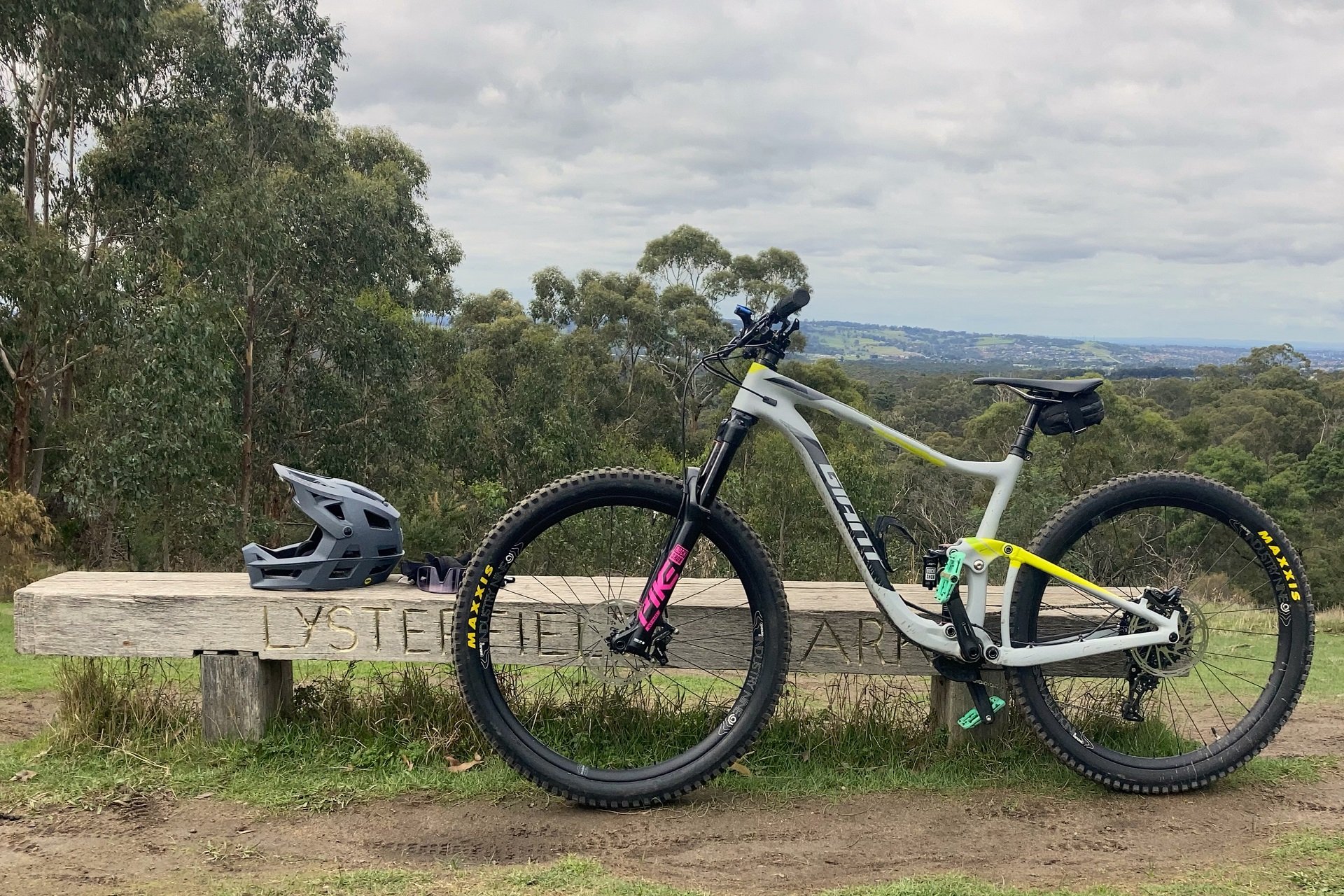
I love this photo as the full face helmet shows intent and really doesn't look out of place. I'd be down to try this Anthem SX² with a mullet setup using a shorter travel fork and a 29" front wheel.
#HotForMullet
Instead of a longer travel fork, how about dropping down to a 120mm fork and combining the -2° angleset upgrade with a 29" wheel? That's a lot less min-maxed than tossing a new air spring shaft in the existing Pike. But lets say that Andrew's fork was unsupported anyway and he needed to upgrade due to some chassis issues. For the extra cost of lacing up a fresh rim I think a mullet setup would be one very interesting way to get a different experience out of the same bike.
Giant had a rocky relationship with 29" wheels. They first made some bad 29ers, and then they abandoned the size to chase the one-true-hoop as they, more than anyone, marketed the living shit out of the middle ground (that's not really the middle), of 650b. Also called 27" or 27.5" depending on who you're talking to. But, looking back it's actually easy to imagine a scenario where Giant could have been the first big player pushing mullet bikes and I think any of their rigs from this era with their relatively long chainstays would be amenable to a -2° angleset and a 29" front wheel.
Specific to Andrew's bike, there are some fun 120mm 29'er forks on the market like the Manitout R7 or the RockShox SID that are plenty stiff, and very light, that would suit such a project. That's assuming that frame outlasts the fork. He's looking to replace it at some point anyway, and he's keen on the mixed-wheel thing. For the time being, there's clearly no better suspension value than servicing what you already own and I think these Pike RC Solo Air forks stand up well against current models.
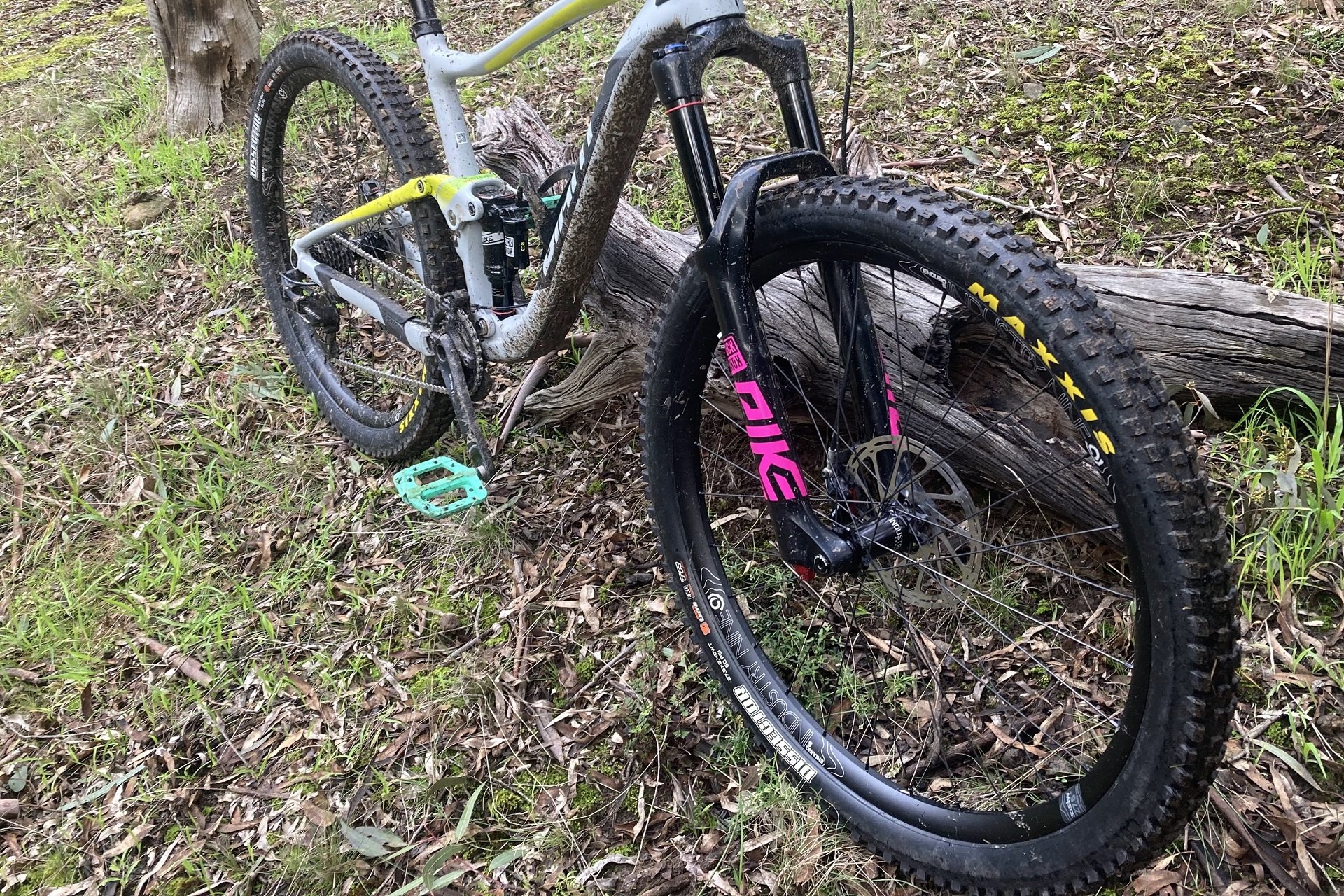
Flat pedals and Dissectors front and rear. Clearly this bike was built to slalom corners?
'Everywhere' MTBs
With the 180mm dropper and a static head tube angle (HTA) somewhere around 65° thanks to the Angleset and over-forking, Andrew's Anthem SX would fit in nicely with our local Shore-XC, Slack-C, or 'Shore Country', scene. However we'd choose to micro-categorize this rig, I think in the current form it's a rubber swap away from being usable pretty much anywhere. The fact it's a five year old, basically six model-years old bike that still looks fresh is neat too. Whether it's because aesthetic changes have slowed down at a similar rate to geometry or simply because all the design funds are being put into adding batteries to everything, I think this SX² looks very current too. That doesn't matter to a lot of folks but I'm sure it would keep more than a few riders looking at upgrading their current rig rather than spending for something new.
The Anthem SX geometry is already in decently close-to-current territory with a 67.5° HTA and a 452mm Reach & 587mm Stack for a Large frame. As with many bikes, there's clearly an XXL and maybe even an XXXL size missing if we're going by Reach and the seat tubes are probably too long, and too slack, for most riders to size up two rungs. Maybe more than any bike in the Min-Max series thus far, the addition of the angleset, which slackens the HTA while also steepening the STA a bit, makes this build.
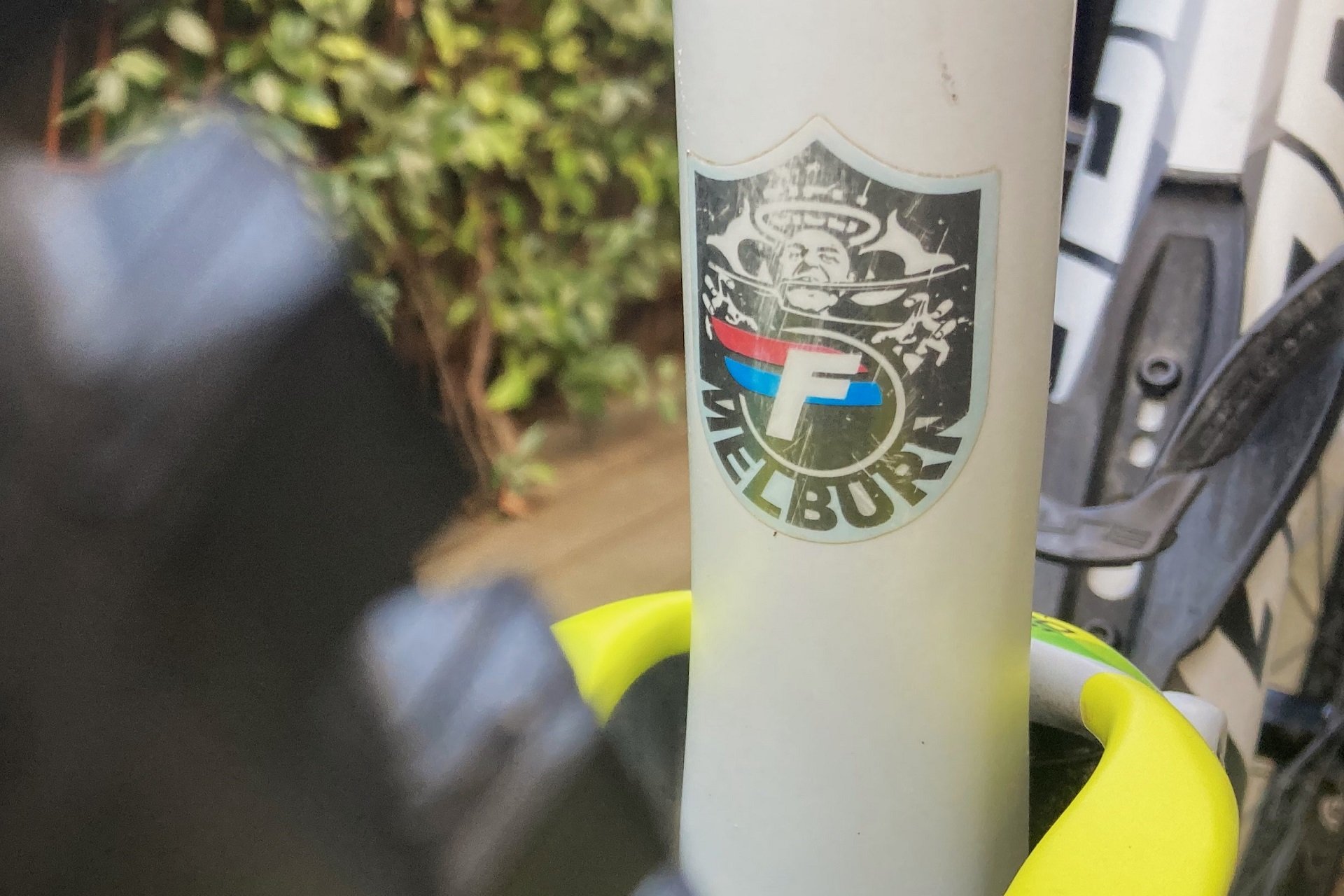
Plenty of detritus tossed against that Melbourne sticker.

Yet another Min-Max entry that clearly is not from Vancouver's North Shore.
I heard an interesting opinion the other day that this will be the category of self-powered mountain bikes - somewhere in the 120mm-ish rear and 140mm-ish front travel range - that will come to dominate local riding, even aggressive local riding, here on the North Shore in the coming years. The bikes are slower on the gnarliest descents compared to a full-blown Enduro rig, yes. But they're much more fun on tamer trails and with big brakes, good rubber, and suspension well setup they're clearly capable. I'm currently spending all my riding time on a 120mm/120mm mullet with a HTA sitting somewhere in the 63.5° range and it's a ridiculous amount of fun. But, and I'm not back yet in terms of riding a bike in anger, it sure does love to try and get me into trouble.
Tires, as noted, become the most interesting differentiator between a bike set up with more of an uphill bias, all-around bias, or downhill bias but even then lighter inserts hitting the market level out questions of rim protection and sidewall support for some more supple, less knobby options that roll faster but grip well with lower pressures. Great geometry is here, powerful trail brakes are here, and there are some excellent stiff-and-light short travel suspension forks as well as some excellent inline shocks. I'd guess we'll see a much higher percentage of bike reviews on NSMB like those listed in my opening.
In a way, I think this trend was announced almost a decade ago with bikes like the Kona Process 111, Transition Smuggler, and Banshee Phantom. It's taken the blending of these short travel, aggressive 29ers with lighter and more efficient XC machines to get us here. And, it's neat that, wheelsize aside, Andrew's 2017 Giant Anthem Advanced SX, or SX² as I like to call it, is really on trend, five years and an angleset later.
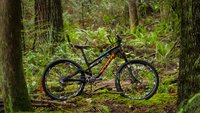
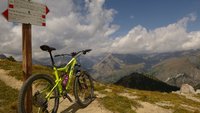
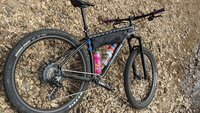
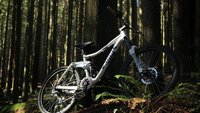
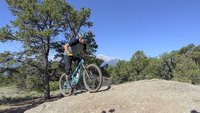
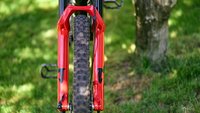

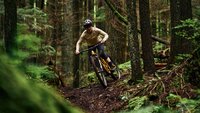
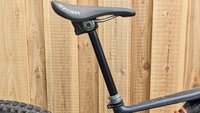


Comments
Adam Brown
1 year, 10 months ago
I ride this same bike as a mullet (120mm, no angleset) and I love it. Super fun. The mullet transformed the bike. It's perfect for my local trails. No plans to upgrade.
Reply
Andrew Major
1 year, 10 months ago
Neat! Are you still mostly stock otherwise? Most curious what shock you’re running and how the front/rear balance.
Also most curious what tires you’re on. Ha.
Any photos to share?
Reply
Adam Brown
1 year, 10 months ago
Almost nothing stock. I've had the bike for a few years now and moved lots of old parts onto it. I've got a Shimano preference, so all the SRAM stuff got replaced with XT 11 speed (except a lovely SRAM cassette).
I run Dissector front, with an Aggressor rear. I don't think about tires anymore. That set up works great for me.
I still have the stock Super Deluxe and a 34 Grip up front. Super happy with both. I know a piggy-back is an aesthetic thing at times, but I really enjoy the Super Deluxe. I've run them on other bikes and have had great luck.
In its stock form, I loved the bike at slower speed, tech stuff, but it was really out of its league on higher speed rough trails. Just not fun to ride in that kind of stuff. The mullet has made it more capable and still super fun. I'm really tempted by an angleset now, though I've got very few complaints with how it rides at the moment. My local trails are tame.
https://www.pinkbike.com/photo/23090254/
Reply
Andrew Major
1 year, 10 months ago
For tires, it all comes down to the sports surface and also rubber management. I know some folks who like the Aggressor rear, and even more who love the Dissector rear, when it's loose-over-hard on the Shore. But who find them universally terrifying in our wet and greasy season.
For riders that want to run one set of tires year round, they aren't winning options but for riders who change seasonally, they're a good choice (particularly as rear tires).
Reply
gubbinalia
1 year, 10 months ago
Oh man, nothing quite like a promo video with a clean-shaven Carl Decker to get an XC racer's pulse throbbing circa 2016. No mustache, no dropper, no problem. (And by the way, did you catch his melancholic ode to trunnion mount?! Had me laughing uproariously.)
Although -- without double-checking myself -- I'm 90% sure that Decker won Downieville on an Advanced SX with 130mm RS-1 and a Magic Mary up front that summer? Which spoke to Giant's confusing double-model situation, at least as it played out at my local LBS at the time, which happened to be a Giant dealer: there weren't many customers in our neck of the woods who were interested in a non-29er XC bike (shorter women and pre-teens aside), so the race Anthem in 27.5 didn't sell all that briskly. But nor were there many folks hunting for trail/all-mountain bikes who would settle for a frame with only 110mm travel, so the Advanced SX was a rare sight, as well. (Actually, I remember doing a three-stage enduro race -- in the early phases of enduro racing in this area -- with a guy who was running a 100/100 Anthem with a Fox 32 that promptly lost most of its damping after the first stage. He finished pretty well, all the same.)
I have to ask, though, what makes you associate these early Giant forays into downcountry territory with bikes like the Smuggler, Process 111 or Phantom? That seems sort of like giving Giant too much credit -- they weren't (and, ahem, aren't) pushing the envelope on geo or thinking outside of the established industry norms in nearly the same way as Transition/Kona/Banshee. Looking past brand differentiation (I don't think anyone wanting a sub-27lb., almost-as-quick-pedaling-as-an-XC-bike in those days would have even considered Transition, let alone Banshee!), there's a certain type of rider who fits well with a contemporary over-forked XC bike like an Epic Evo or Blur TR, vs. the rider who clicks with a new Stumpjumper, Tallboy 4 or something even more ponderous-climbing like an Optic. (Which also speaks to the popularity of the Spur, and to a lesser extent the new Element, shooting the gap between the "long-travel XC" and "short-travel trail" categories, or whatever the heck you want to call them.)
On tires: great point about triangulating between sketchy XC rubber and heavier trail-worthy tires. I've been disappointed with many of these tweener, ~850-950g tires but the new Wicked Will has hit the mark for me. I've got a front/rear set of them in the SuperGround casing (865g) on my XC bike, and one in SuperTrail (920g) on the rear of my singlespeed, both Addix Speed compound (though I'm desperately hoping Schwalbe releases the Soft version here in the States eventually). They're not the best in the wet but the aggressive siping across the top lugs helps them skate by OK. The rolling resistance is pretty dang low, though, and when they do break traction in looser stuff it's fairly predictable and not too surprising.
Reply
Andrew Major
1 year, 10 months ago
I almost had a heart attack and had to rush to re-read what I wrote. I definitely don’t give Giant credit for “pushing the envelope” or innovating in any way on anything so you had me worried. That’s not to say they don’t make great bikes for reasonable money but generally speaking they’re 2-3 years behind whatever they’re making for Trek (who also don’t generally get accused of jumping off the jagged edge) and sometimes their rigs don’t really land at all.
My conclusion is about the general future of self-powered mountain bikes and specifically about the relevance of Andrew’s Anthem SX in the conversation:
“…five years and an angleset later.”
Andrew’s bike is over-forked and sporting a -2* Angleset and I think in that guise it’s a neat conversation piece. Mulleted I think it would be even more the case.
———
The flip side is a Process 111 with an Angleset (mulleted or otherwise) is even more rad. My point simply being that I think aggressive fully-people-pedaled bikes in the future will share more in common with these capable rigs than the aggressive Enduro bikes of today.
Carl Decker is an animal. But that’s a great example of the capability of a short travel bike with good rubber (I bet he would have loved that Angleset though).
Reply
gubbinalia
1 year, 10 months ago
Ha! No intent to induce panic on my part, I promise. I was actually re-reading those last few paragraphs myself, trying to figure out what I missed, because I knew you weren't trying to laud Giant's mid-2010s design team, but I couldn't figure out what the broader point you were making was. I think the nuance that I missed was that you were making a separate point at the beginning of the piece -- that "some of the most exciting meat-powered rigs on the market right now aren't a huge leap from the thinking behind Andrew's version the SX," which I 100% agree with, and really don't think is up for debate given how lively the "downcountry" category is right now_--_ than you were at the end of the piece, when you brought up the Process 111 et al. Let me admit, Andrew: sometimes my mid-work-day ability to digest your insights is a bit dulled; I recant my testimony! :-)
The even more nuanced point you're bringing up about "fully-people-pedaled bikes" is, I think, worthy of a future editorial -- whether here or on MeatEngines. I live in an extremely un-eBike-friendly area, and we haven't come close to reaching blender-bike saturation here, but when we do I imagine many of the meat-powered riders may be switching to lighter, shorter-travel machines instead of hopping on motorized all-mountain/enduro category rigs.
The Path Podcast did a great segment on this topic, pondering what will change about the buying habits of highly evolved MTB consumers if they continue to resist the encroachment of motorization. As one of the podcast hosts noted, once the buyer has recognized that they're *not* getting the most expensive, most technically-equipped, most "advanced" (heavy scare-quotes) bike on the market, why continue choosing a bike that's at the upper tier of the pyramid in terms of suspension capability, when a lighter short-travel bike will make for a more immediate, lively riding experience, and go uphill faster to boot?!
Reply
Andrew Major
1 year, 10 months ago
I'm evolving my thoughts on it all. I just got back from what I'd call my first proper ride since my injury in January. Out with my friend Mr. Lungtastic pushing things a little bit on the climb (so out of shape) and even on the descent (Blue/Black trail - certainly still dialing it back the right amount).
I was only my own 120-ish/120mm bike. Mulleted, scraping pedals, somewhere around a 63.5° head tube angle static. This means even if I fully bottom the fork with the rear shock locked out (which doesn't happen) I'd be riding a slacker bike than a lot of previous gen 120mm machines.
I run the same tires I was running on the 150mm/170mm Banshee Titan. Same brakes. Same length of dropper post. There are many places that the Titan beats the snot out of my little Rifty in a straight line, but this bike climbs better out of the saddle, is significantly more pumpy and playful, and loves to be worked down the trail. And, I'll be riding exactly the same terrain on it. I think that's cool. Not a brand thing, I think an angleset-equipped Banshee Phantom would be a joy too.
I don't want to give up fun on the descents but I'll happily give up a bit of speed for an overall experience I'm looking for. I am the person who loves rigid #1FG riding though so certainly measure out some salt when reading my opinions on bike travel.
Reply
gubbinalia
1 year, 10 months ago
Ah, congrats on that first "real" ride! Always feels *amazing* to be back in the saddle, pedaling briskly, descending with purpose, for the first time after some time away due to injury, busy-ness, or (in my local case) five months of fatbiking and skiing. Will be interested to keep up with your recovery and hear how things evolve.
That's fantastic to hear the Rift Zone build is panning out so far. I'm looking forward to reading a full build breakdown. (I was a bit surprised you didn't just go for a Phantom frame and an angleset, as you reference, given your affinity for all (many) things Banshee.) I personally would not build a shorter travel bike with the same tires as a longer-travel one -- I like the game of building 110-120mm bikes up *almost* as light as a 100mm race bike, but with just enough concessions to descending to make them survivable on steeper stuff -- but I take your point about the incredible versatility of a short-travel bike. "Pumpy" is a great word for such bikes, btw.
Ha, consider the salt measured! I, too love hardtail'ing and singlespeeding (not a rigid convert, regrettably!), but if anything I think it's turned me into a suspension snob: when I am riding a fully-suspended bike I feel like I need it to be fully tuned and dialed in -- the shock needs to feel great, the linkage needs to feel predictable and active, everything needs to work in concert -- or else I'd rather just be on a hardtail. After all, a hardtail is nothing if not predictable and easy to tune perfectly; you just need to dial in tire pressure/insert usage and away thou goest. Maybe that's not true of all hardtail riders but if anything I listen to the opinions of folks on non-suspended bikes *more* closely than I would listen to someone who exclusively rides, say, 150mm+ FS bikes and likely is losing the forest for the trees in their impressions of the ride as a whole.
Reply
Andrew Major
1 year, 10 months ago
The Rifty is my personal bike and I wouldn’t personally choose to own a Trunnion mount bike.
It checks lots of other boxes too though. I had a previous generation frame so I already knew it would be a fun fit for my rehab bike. It fits my ‘good geometry is free’ mantra, being a budget friendly bike that rides really well, and Marin had inventory available in 2022.
I should play with some lighter tires at some point, but for now I’m loving the wicked weirdness of my build. The 2.8” Vigilante with CushCore Plus wedged into a Manitou R7 makes me giggle.
———
If you like single-speeding then you really NEED (you don’t actually) to try a rigid fork and Plus tire setup at some point. It’s a beautiful devolution that is so simply ‘right.’
Ian St.Martin
1 year, 10 months ago
Is your 2022 mullet Rift Zone a 'Rift Zone 29' with a smaller wheel in the back? With that and a -2* angleset, are there any other major changes?
Reply
Andrew Major
1 year, 10 months ago
Yeah, as with the Titan I reviewed, I just stuck a smaller wheel in the back without making other changes. Then add the -2d headset.
If you’re worried about BB height you can over-fork the bike by 1-2cm (go from 130mm to 140mm or 150mm fork) but I’m running ~ the stock A-to-C height.
I guess I should clarify, mine’s not stock. But no secret magics going on either, which is what I assumed you were asking?
cheapondirt
1 year, 10 months ago
The model of matching tires is admirable. Finishing the old front as a rear is kind to both the planet and the wallet.
Don't want to do it myself though, not where I am, anyway.
Reply
Andrew Major
1 year, 10 months ago
This is a great point! Min-maxing inside a min-maxing article. F***ing Inception over here!
Reply
Lynx .
1 year, 10 months ago
Hahaha, another good one Andrew, especially the call out on Giant's failure in the early 29er market and then their UTTER BS 650B push as the greatest thing since sliced bread, when in fact it's so much closer to a 26" wheel than a 29" it's not funny. Definitely think this would benefit immensely having a 29" front wheel on a bit less travel fork - I did it with my OG '05 Trance 26" rear/29" front, REBA fork lowered to 80mm travel (maybe 100mm can't recall for sure), MAJOR improvement, made it so I could actually ride it with some confidence and have fun, this after moving to 29ers 2007 (did the conversion in '08). Actually it felt and worked a bit more balanced when I put a 650B on the front in 2012, neither experiment was long lasted, just fun experiments to see "what if".
Reply
Andrew Major
1 year, 10 months ago
I should note that I do have an appreciation of Giant in terms of their balance of manufacturing quality and price. I also very much enjoyed riding the gen 1 (shock basket) and gen 2 Reign and Reign X bikes and I still look back at how remarkable some of those builds were for the money.
But yeah, add some imagination and there are a number of ‘what if’ moments in their timeline.
Reply
Lynx .
1 year, 10 months ago
Note the cable routing on my XL Trance, that was not stock the first year, neither were full compliment pivot bearings, but after I and several others had to change our bearings and were getting kinks in our shift cables run the stock way -it went from the TT to CS, so on the sizes over SM it didn't work and kinked really badly.
Price to performance was definitely a thing with them, I paid $1400 USD for an LX build bike with DukeXC fork, but soon upgraded a lot due to finding deals and the fact that those old Duke had HORRIBLE bushing play I couldn't stand.
Don't know WTF it was showing 2 identical photos, fixed it to include the first 26/29 conversion in '08.
Reply
Andrew Major
1 year, 10 months ago
Duke and Psylo both. Not that the subsequent Reba & Revelation we’re much better (they were) but it’s hard to qualify for newer riders how much the 2014 Pike changed their game.
Reply
silverbansheebike
1 year, 10 months ago
Nice ride! Finally a min-max article of a bike that already has an angleset in it, haha.
This bike kind of reminds me of my brothers Specialized Camber, overforked to 140 in the front. But now I wonder how it would've done instead with a 27.5 rear and an angleset... That was the first 29er I ever rode, which felt HUGE to me at the time (not really considering that he's also on an XL, which probably was the greater contributing factor here).
Reply
Alex D
1 year, 10 months ago
This is very similar to what I'm currently riding ('20 Trance Advanced Pro 2). Good callout on the trunnion bearings, will have to keep an eye on that.
Generally, the bike is awesome. My configuration is more XCish in some ways; it's running 2.6 XR4/XR2, XX1/11 (borrowing the DUB Eagle cranks though), the 210mm version of that OneUp post, and 35mm EIE wheels on 54 POE Bitex hubs. All that pushed the weight in XL down into the 25s, so it's not much slower on the uphills than the downcountry Scalpel I replaced, but far, far more confident on the downhills. The suspension is stock (Fox Rhythm and whatever the non-piggyback shock is) because I can't see a reason to upgrade it.
The only real downside of the bike is the slack seat tube. I've got long legs, and even with the saddle mashed forward, I'm still a little too far back. That's why I haven't overforked it (despite that the low bottom bracket would probably benefit). Tentative plans for a 1D angleset for the stock 66.5 HTA. The new Trance already goes this way, so I'll probably just enjoy it for a few years and move on that one. Really impressed with the Maestro platform.
Reply
Andrew Major
1 year, 10 months ago
What length stem are you running with that setup? Would it be possible to switch to a forward offset seat post (9Point8 is currently the only option, though their head may fit other posts) go a touch longer on the stem, and fix the pedaling position, for you?
SE4/SE2 (I love the extra bit of support over the XR) is a perfect tire combo for this sort of bike I think. Certainly under-rated due to the Bontrager logo on the side.
Reply
Alex D
1 year, 10 months ago
Stem length is a work-in-progress. The stock 60mm felt long in the seated position with 3" of saddle-bar drop on my bike and a bit sluggish with 800mm bars. I downsized to 40mm for a few weeks. This improved the seated fit and steering response, but it's harder to keep the front wheel weighted in long, sweeping turns, and reach feels a bit short when I'm standing up.
I just installed a 70/35D stem with a 60mm effective length and an extra inch of height relative to the original 60mm. Might also try a 50mm. Shorter riser stems don't really exist, so if the extra height helps, the long-term solve may be to swap the fork to get an uncut steer.
The 9Point8 post with an offset is the R model limited to 150mm travel. The head and tube are one-piece, I don't even think it's cross-compatible with the non-R Fall Line. If OneUp had the same post with an offset head, I'd buy it tomorrow.
On tires-- the Bontrager 2.6s weren't the best on the stock 30mm rims. Too much squirm in the back, almost the point of risking a burp, at the correct tire pressures for compliance. The 35s are a surprisingly noticeable improvement. When they start to wear out, I might try the SE-series if inserts don't tempt me before then.
Reply
Andrew Major
1 year, 10 months ago
I've looked at the 9Point8 forward offset head from every angle online (haven't had one in person) and I don't see why it wouldn't bolt on to most posts? Maybe not posts like OneUp that have an air valve at the top (without having it in hand it's hard to judge clearance).
It just replaces your existed top and lower clamp with their base and then the clamps sideload?
I don't need a forward offset head for anything, so not prepared to drop the cash to play with it. But I have a couple of friends who'd love their saddles more forward so maybe I can convince one to buy a lottery ticket to forward offset land and confirm it.
Reply
Alex D
1 year, 10 months ago
How interesting, thanks. I wonder if the curve and screw spacing matches OneUp. Need to do some Photoshop layering.
What's your take on a 2D angleset for a bike that already has a 66.5D head angle? Would the bike still turn at 64.5D?
Reply
Andrew Major
1 year, 10 months ago
My FS bike is static at 65.5D in the stock form. I’ve mulleted it which drops the BB, and slacks out the HTA maybe 0.5D and then installed a -2D headset. Depending on my fork setup I’d guess it’s sitting static at 63D/63.5D and I run more sag rear than front.
It’s super fun. Climbs well, though I often do uphill ladders out of the saddle which does let me lean into corners more. Downhill it makes me giggle.
The chainstays are 425mm which does unbalance the bike a bit in some DH situations relative to my Walt or say the Banshee Titan (455mm stays). I’d love to have adjustable chainstay length, say 430-445mm so I could play around with balancing it.
But yeah, no problem weighting the front or driving it into corners or anything. Can’t wait until I’m back at full pop (or at least fill pop for me), hopefully in the fall sometime, because I think going DH slack on short(er) travel bikes is going to be the level of shenanigans a lot of riders are looking for.
The good news is it’s just a headset. Can always punch it out.
Andrew Major
1 year, 10 months ago
Yeah, 2.6" tires I much prefer an i35 or i40 rim. In the same vein, folks talk about liking their 2.8" tires on i35 rims but I find for most brands an i40 fosters a tire shape that is less sensitive to 0.5psi.
If you go SE let me know how you like them. I'm now on the SE casing with CushCore but I certainly care more about run-flat, traction, feel, and rim protection than about weight or rolling speed. I know those metrics balance out differently everywhere and for different riders.
Reply
Tjaard Breeuwer
1 year, 10 months ago
Interesting about rim width.
My experience the last year or 2 has been the opposite. It’s the tire profile in cross section that’s the issue.
I thought the same thing: 2.8 on 40mm, 2.4 on 30mm, so 2.6 on 35mm.
I bought a 2.6 Slaughter, put it on a 35mm rim and pulled it right off. It was completely flat across the crown, with sidewalls sticking out past the tread.
On a 30 mm rim it’s perfectly shaped, and the 2.8 fit nicely on the 35mm rim.
I have a 2.6 Assegai on a 30mm rim, and it’s a great shape, I can’t imagine it would have a good shape on a 35mm rim.
Same with the 2.6 Butcher(although, that’s really a 2.5, so…).
The Vigilante 2.6 on 28 mm rim has a great shape, but certainly could go wider, I just don’t have a wider rimmed front wheel to test it, still I worry 35mm might be too much.
I like the idea of wider tires and wider rims, especially in the front, but, despite Maxxis’ “wide-trail” label, there seems to be lack of wide enough tread to cover the casing on wide rims.
Reply
Andrew Major
1 year, 10 months ago
2.6” Slaughter is a weird tire. I preferred it on an i30 rim too. It’s so tall as it is, but then on a wider rim you’re dragging the side knobs around. I much preferred E13ms semi-slick but it didn’t have the volume. Maybe just too many variables to do a good, larger, semi?
More recently for 2.6” I’ve run the new Pugatory and it rolls fast and digs hard as a rear. Really impressed.
Alex D
1 year, 10 months ago
Many tire brands straight-up lie about width. To me, 2.6 means your casing is 2.6 on the expected i35 rim at riding tire pressure. Bontrager tires all qualify; they're proper high-volume beefcakes. To Maxxis, 2.6 means the edge knobs might just make 2.55 inches at 40 PSI. There was at least one 2.6 I read about recently with a 2.4" casing. When there's no consistency in casing width or tread spacing, it's hard to generalize about rim width.
Andrew Major
1 year, 10 months ago
@Alex, absolutely a key point. Even between one brand’s lineup looking at ‘XC’ v. ‘Aggressive’ rubber, how tires are measured isn’t always clear. Sometimes it’s clearly aspirational.
A reminder to all of us that WTB pushed a better system in the ‘00s of height and width that was easy to measure/report and it went nowhere. Companies will only provide more information if we push for it.
Bontrager tires are true to size in my experience even across the line. A 2.6” SE2 or SE4 or SE5 are all going to measure ~ the same on the same internal width rim.
So taking Bontrager as true to size (I’d also give WTB credit for this having recently measured Vigilantes and 2.6” Rangers), I’d be comfortable in generalizing that if every tire was true to size like them a 2.6” has a better shape on an i35 or even i40 rim compared to an i30 rim.
Lynx .
1 year, 10 months ago
I'm going to go into the "It depends" camp on this one. For me, in general on the bike I ride most, Rigid Unit, 2.6" is for i35 or narrower, on i40 it feels harsh AF, only just recently tried that one, lesson learned, was an uncomfortable ride. If however I was putting the same tyre on an FS, then the extra sidewall support I think it could go either way - I once ran the On One Chunky Monkey 2.4" on my i39 Dually front wheel and it was insane how good it was.
So for me, with most riding happening on the rigid Unit I'd say <2.6" goes on i30-i35, 2.8" goes on i35 or i40 and 3.0" goes on i40 or i45, all depending on which brand we're talking. Talking brands who don't lie, have to say that Schwalbe has been good with there sizing for me, Maxxis as usual is always just barely there at max inflation.
On my Phantom, I have several wheels, but running my 2.3" tyres, I run an i25 rear/i29 front, then have the i35 wheels if I want to put on some big rubber and go try to hang with the boys on their enduro rigs, or just pull out the Prime.
Also depends on the type of riding you're doing, terrain/trail type and trail speed. Most of my riding on the rigid is of course a lot slower (mostly) than on an FS and so the qualities I look for are different, don't really have any super bermed anything here, so no extreme lean angles needed.
Reply
Justin White
1 year, 10 months ago
The Super Deluxe piggyback shock might actually have been chosen because they wanted more LSC adjustability. The best non-piggyback Deluxe (Ultimate, or previously RCT) only had a 3-position LSC and lock-out/platform switch, ala Fox's RP23, while the Super Deluxe Ultimate has 8 or 10 clicks for LSC, or something like that. Though I couldn't see from the pics if this one has that dial...
Reply
Andrew Major
1 year, 10 months ago
It’s a 110mm travel frame. Regardless of the adjustment options I don’t think it’s stretching anyone’s imagination to assume this was an aesthetic choice?
Reply
Justin White
1 year, 10 months ago
Hmm, I figured short travel might actually benefit more from LSC adjustment. Being able to precisely resist body weight movements and keep the rear dynamically in the sweet spot of that itty bitty travel could do wonders to keep it in the supple traction zone and away from the bottom-out zone, or the "wall of progression" zone if it's already stuffed full of tokens to avoid those bottom-outs.
Piggyback also makes it a bit easier to make weird tweaks like more IFP pressure for even more end-stroke progression beyond, or in place of, max tokens, which could also be useful for short travel.
Like I said, I can't tell exactly what shock it is, it may not even have LSC adjust. Just offering up why I would always* pick a piggyback for reasons other than "needing" more oil, or aesthetics, no matter the travel.
*(I prefer the feel of Fox, but they also have zero non-piggyback options with LSC adjustment more than the same 3 granular choices in open mode)
Reply
Andrew Major
1 year, 10 months ago
It's funny, I hear and read this sentiment quite often. I guess the logic stream makes sense, you have less travel so it needs to be as dialed as possible.
In all of my experiences, regardless of what suspension design we're talking about, the longer travel a bike gets the trickier it is to set up in terms of balance. Balancing the front and rear suspension. Balancing good pedaling performance with excellent descending capabilities. Etc.
It's amazing how a 120mm bike, like the basic 1500 USD Hawk Hill I tested in 2017, can pedal very well, be fun and poppy on the trail, and remain composed with one of the cheapest OE shocks on the market (most basic X-Fusion O2) but if you put that same shock on a 150mm+ travel bike it would either pedal like garbage or require so much anti-squat that it descends like a much shorter travel bike.
If you were to ride a couple of bikes back to back with similar suspension platforms/kinematics (again, any system) but with significantly different amounts of travel with the most basic RockShox Deluxe coil or air shocks (rebound only), I'm positive you'd come to the same conclusion. Lots of fun on the 120mm bike and you'd be wishing for a higher-end shock with tuneable low-speed compression on the longer travel rig.
I find the same to be true with forks as well. On a 150mm+ fork I'm playing with the damper, volume spacers, trying to find that sweet spot between ride height, bottom out, composure in steep terrain.
On my (yes, super-slack) 120mm travel bike I can run the fork quite linear, use all the travel, it doesn't bother me when it bottoms out, and it's much easier to balance with the rear suspension (which I also run very linear with less sag).
It's neat? I also think it would be a universal experience for folks doing A:B testing.
Reply
Tjaard Breeuwer
1 year, 10 months ago
I have never compared back to back, but I can see your point.
At the very least, a short travel bike doesn’t experience big changes in geometry due to suspension movement, including the front/rear action, so you don’t have to worry about that.
Since I am firmly of the belief that geometry is the most important part of a bike, I can see your reasoning.
Reply
Andrew Major
1 year, 10 months ago
Not that I’m not currently running a shock with piles of adjustments on my 120mm bike (CCDB Air IL) or that I didn’t take the time to find a good setup. Hahaha.
But the % performance difference moving to a more basic shock is going to be minor compared to a ‘big bike.’
Will have more on that in the fall as I’ll also be running a Manitou Mara (not Mara Pro).
Justin White
1 year, 10 months ago
Why do you care more on the longer travel? Don't care about bottom outs at 120, but need to balance against bottom outs at 150? Makes sense you would be ok with a less ideal (due to lack of easy adjustments) shock setup in that case, but that's not the travel number's fault, that's you weirdness. Someone who wants to balance against bottoming at 120 would benefit from a more ideal (via easy adjustments) shock setup just as much as you at 150.
I don't think it would be universal, at all. Since I, for one, want the balance at all travels, and I know way more riders on the same page, than those whose care about balance goes down with travel numbers.
Reply
Andrew Major
1 year, 10 months ago
“but that's not the travel number's fault, that's you weirdness”
One of my old bike shop managers, Rabbit, used to have a perfect saying for situations like this… he’d look you right in the eye and say:
“My boss says I’m only allowed to tell one customer to f*ck off per year and I’m not wasting it on you.”
Anyway, I answered your question a couple paragraphs higher in the comment you’re responding too:
“In all of my experiences, regardless of what suspension design we're talking about, the longer travel a bike gets the trickier it is to set up in terms of balance. Balancing the front and rear suspension. Balancing good pedaling performance with excellent descending capabilities. Etc.”
Tjaard Breeuwer
1 year, 10 months ago
For this short travel-but-not-XC-race category of bikes, also take a look at the Specialized Ground Control tires. Roller testing showed excellent (low) rolling resistance, and they have decent traction, are available in a variety of casing and compound options, and most importantly: They are actually available online and in stores, and not crazy expensive.
Reply
mnihiser
1 year, 10 months ago
I just bought a Ground Control a month ago. Really liking it for our local terrain. I don't need meaty, super grippy rubber and the GC rolls very fast.
Reply
Lynx .
1 year, 10 months ago
There's only one problem with that rec Tjaard, they're from evil corp :-\ Also, not sure about the current stuff, but the casings on them vs say Maxxis, weight for weight/EXO vs Control, the Maxxis wins hands down in durability, not even a fair fight.
My pick for a good tyre that's pretty fast rolling and also durable, would be something from Schwalbe in the SpeedGrip compound, like the old Nobby Nic. Not sure what the new NN is like, if it's as fast, but the old V2 version sure rolls quick for me in the SG compound, even in a 2.6" width compared to Maxxis 3C compound option like Aggressor/DHF in 2.3".
Reply
silverbansheebike
1 year, 10 months ago
I had a poor experience with the NN, but this was around 2012. Not sure if because they were OEM spec maybe the compound was different... but they never wore down, which means they never really gripped anything either! It sure was fast, though.
Reply
Andrew Major
1 year, 10 months ago
Schwalbe had some AWFUL OE versions of their tires over the years. Sidewalls made of paper and rubber so hard it would last forever but sadly with the same model names. I know a number of riders who will never touch their products again after buying a Trek or Ghost (lots of bikes came with the tires but there are two specific friends/bikes I'm thinking of).
They're now much better about downcycling model names and tread patterns and using those for cheaper OE rubber.
Still, like Maxxis, you can buy an okay or really good tire in most models depending on rubber so it's good to know what you're getting.
Reply
Adam Brown
1 year, 10 months ago
OE Nobby Nics that came stock on this bike were SCARY. No front-end bite at all.
Reply
Andrew Major
1 year, 10 months ago
I didn't generally love that generation of the Nic either way. The Racing Ralph somehow was a better tire in almost all conditions, even on the front, descending techy terrain.
silverbansheebike
1 year, 10 months ago
Haha! I think the bike i had was the Ghost you are picturing. Poor thing, frame was outlasted by a set of tires.
Good to know things have improved, might be more open to Schwalbe in the future.
Reply
Andrew Major
1 year, 10 months ago
Awful bike. We were just talking about it today at #CumberlandWorx and my friend Larry Talker said it may have been the worst bike he’s ever owned. He’s been riding bikes off-road since rigid forks weren’t a choice, so the speaks volumes.
Lynx .
1 year, 10 months ago
Yeah, Schwalbe had a lot of problems back then, not only the crappy OEM tyres, but also in their better version the side knobs used to come off if you looked at them too hard. Happy to say that all that has changed since they introduced the new stuff back 2017 when they introduced the ADDIX lineup. I was skeptical too, but gave it a chance and am super glad I did, because the NN/HD in SpeedGrip 2.6" set I got, are really amazing, they roll so good, yet have amazing traction and I got both on sale for like 50-60% normal retail.
> Silverbansheebike - I had a poor experience with the NN, but this was around 2012. Not sure if because they were OEM spec maybe the compound was different... but they never wore down, which means they never really gripped anything either! It sure was fast, though.
Reply
Please log in to leave a comment.